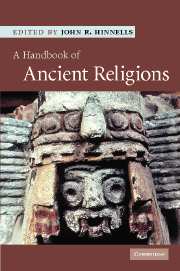Book contents
- Frontmatter
- Contents
- List of illustrations
- List of maps
- List of tables
- List of contributors
- Introduction
- 1 Palaeolithic art and religion
- 2 Ancient Egypt
- 3 Religion in ancient Ugarit
- 4 Mesopotamia
- 5 Ancient Israel to the fall of the Second Temple
- 6 Greek religion
- 7 Religions in the Roman Empire
- 8 Ancient Europe
- 9 The Indus Civilization
- 10 The religion of ancient China
- 11 Aztec and Inca civilizations
- Index
- References
9 - The Indus Civilization
- Frontmatter
- Contents
- List of illustrations
- List of maps
- List of tables
- List of contributors
- Introduction
- 1 Palaeolithic art and religion
- 2 Ancient Egypt
- 3 Religion in ancient Ugarit
- 4 Mesopotamia
- 5 Ancient Israel to the fall of the Second Temple
- 6 Greek religion
- 7 Religions in the Roman Empire
- 8 Ancient Europe
- 9 The Indus Civilization
- 10 The religion of ancient China
- 11 Aztec and Inca civilizations
- Index
- References
Summary
Introduction
Ancient India's first civilization arose on the plains of the Greater Indus Valley of Pakistan and north-western India during the second half of the third millennium BCE (c. 2500–1900 BCE). This has come to be called the Indus Civilization and was the first period of urbanization in the Indian subcontinent. The great cities of the Indus Civilization were Mohenjo-daro and Harappa, both in Pakistan. Mohenjo-daro today is on the western bank of the Indus river in the province of Sindh, and Harappa, 650 km to the north-east, is on the southern bank of the Ravi river in the West Punjab. The ancient Indus peoples lived in a society with marked social classes and craft and career specialists, some of whom knew the art of writing. They engaged in long-distance trade with the Arabian Gulf, Mesopotamia, Iran, Afghanistan and central Asia.
There is no reference to the Indus Civilization in the historical documentation of the subcontinent. This is a contrast to Mesopotamian civilization and Dynastic Egypt, which were noted in the Bible and other literature. But the Vedic texts of ancient India, the earliest of the subcontinent's historical literature, contain no direct reference to the Indus Civilization, and the discovery of these ancient peoples was purely through archaeological excavation (Possehl 1999: 38–154).
The chronology of the Indus Civilization is based on radiocarbon dates, confirmed by good cross-ties to the early history (Akkadian period) of Mesopotamia. Undoubted Indus artefacts (e.g. stamp seals, etched carnelian beads, pottery) have been found in Mesopotamia, and at Susa in south-western Iran.
- Type
- Chapter
- Information
- A Handbook of Ancient Religions , pp. 418 - 489Publisher: Cambridge University PressPrint publication year: 2007
References
- 3
- Cited by

